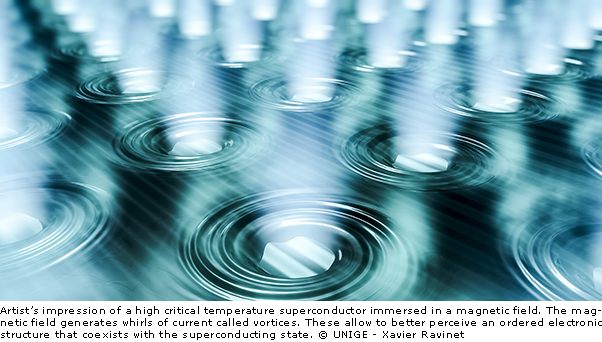Super-conductivity seen in a new light
Superconducting materials have the characteristic of letting an electric current flow without resistance. The study of superconductors with a high critical temperature discovered in the 1980s remains a very attractive research subject for physicists. Indeed, many experimental observations still lack an adequate theoretical description. Researchers from the University of Geneva (UNIGE) in Switzerland and the Technical University Munich in Germany have managed to lift the veil on the electronic characteristics of high-temperature superconductors. Their research, published in Nature Communications, show that the electronic densities measured in these superconductors are a combination of two separate effects. As a result, they propose a new model that suggests the existence of two coexisting states rather than competing ones as was postulated for the past thirty years. A small revolution in the world of superconductivity.

A superconducting material is a material that, below a certain temperature, loses all electrical resistance (equal to zero). When immersed in a magnetic field, high-temperature superconductors (high-Tc) allow this field to penetrate in the form of filamentary regions, called vortices, in which the material is no longer superconducting. Each vortex is a whirl of electronic currents generating their own magnetic field and in which the electronic structure is different from the rest of the material.
Coexistence rather than competition
Some theoretical models describe high-Tc superconductors as a competition between two fundamental states, each developing its own spectral signature. The first is characterized by an ordered spatial arrangement of electrons. The second, corresponding to the superconducting phase, is characterized by electrons assembled in pairs.
«However, by measuring the density of electronic states with local tunneling spectroscopy, we discovered that the spectra that were attributed solely to the core of a vortex, where the material is not in the superconducting state, are also present elsewhere, that is to say in areas where the superconducting state exists. This implies that these spectroscopic signatures do not originate in the vortex cores and cannot be in competition with the superconducting state», explains Christoph Renner, professor in the Department of Quantum Matter Physics of the Faculty of Science at UNIGE. «This study therefore questions the view that these two states are in competition, as largely assumed until now. Instead, they turn out to be two coexisting states that together contribute to the measured spectra», professor Renner says. Indeed, physicists from UNIGE have shown, using theoretical simulation tools, that the experimental spectra can be reproduced perfectly by considering the superposition of the spectroscopic signature of a superconductor and this other electronic signature, brought to light through this new research.
This discovery is a breakthrough towards understanding the nature of the high temperature superconducting state. It puts some theoretical models based on the competition of the two states mentioned above in difficulty. It also sheds new light on the electronic nature of the vortex cores, which potentially has an impact on their dynamics. Mastery of this dynamics, and particularly of the anchoring of vortices that depend on their electronic nature, is critical for many applications, such as high field electromagnets.
Contact :
For more information, please contact Prof. Christoph Renner (Tel. +41 22 379 35 44) or Dr Christophe Berthod (Tel. +41 22 379 68 95).
Reference :
Revisiting the vortex-core tunnelling spectroscopy in YBa2Cu3O7−δ , J. Bruér, I. Maggio-Aprile, N. Jenkins, Z. Ristić, A. Erb, C., Ø. Fischer, C. Renner, Nat. Commun. 7:11139 (2016) DOI
March 31, 20162016
